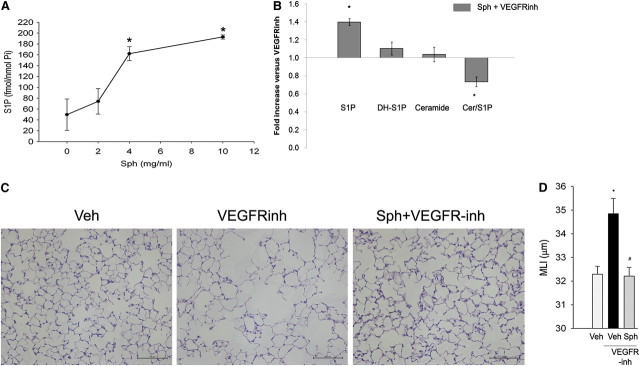Figure 2.
Effect of d-sphingosine supplementation on vascular endothelial growth factor receptor (VEGFR) inhibitor–induced airspace enlargement. (A) Sphingosine 1-phosphate (S1P) levels in the lung on Day 5 after administration of sphingosine (Sph) at the indicated concentrations (mean ± SEM; *P < 0.05; n = 2 or 3 per time point). (B) Changes in sphingolipids S1P, dihydro-S1P (DH-S1P), ceramide, and the ratio of ceramide to S1P in the lungs of mice receiving sphingosine supplementation after VEGFR inhibitor (VEGFR-inh) administration, compared with those animals that were treated with VEGFR inhibitor with vehicle (mean ± SEM; *P < 0.05; n = 5). (C) Representative micrographs of hematoxylin and eosin–stained sections of inflated and fixed alveolar lung tissue from mice treated with vehicle (Veh; 0.5% carboxymethylcellulose), VEGFR-inh (SU5416, 20 mg/kg, subcutaneous; Day 28), or d-sphingosine (Sph; 20 μg, intraperitoneal, daily on Days 1–5 after SU5416 administration). Scale bars, 100 μm. Note the airspace enlargement in the VEGFR inhibitor–treated lungs, which is reduced by treatment with Sph. (D) Morphometric measurements of the mean linear intercept (MLI), indicating airspace size in mice that were treated with Veh, VEGFR-inh, or Sph and VEGFR-inh (mean + SEM; *P < 0.05 vs. Veh; #P < 0.05 vs. VEGFR-inh; n = 5 per group; analysis of variance).

